Page 127 of 364
125
5008_en_Chap06_securite-enfants_ed01-2015
Weight of the child and indicative age
Seat Under 13 kg
(groups 0 (b) a n d 0 +)
Up to approx 1 year From 9 to 18 kg
(g r o u p 1)
1 to 3 years approx From 15 to 25 kg
(group 2)
3 to 6 years approx From 22 to 36 kg
(group 3)
6 to 10 years approx
Front passenger seat (c)
with height adjuster U (R)
U (R)U (R)U (R)
Front passenger seat (c)
without height adjuster X
XXX
7 seats (3 r ow s)
Outer rear seats
2nd row (d) (e)
U* U* U* U*
Centre rear seat
2nd row (d) (e)
UUUU
Rear seats
3rd row U
UUU
*
P
recautions are required when fitting a child seat with a support leg . Refer to the section "Installing a child seat with a support leg" for more
information.
6
Child safety
Page 128 of 364
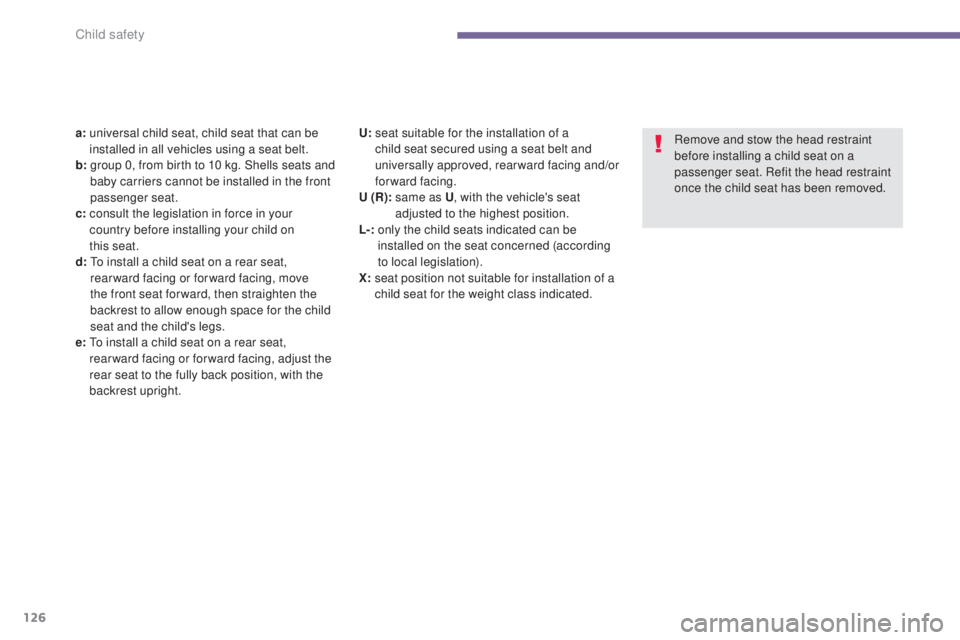
126
5008_en_Chap06_securite-enfants_ed01-2015
a: universal child seat, child seat that can be
installed in all vehicles using a seat belt.
b:
g
roup 0, from birth to 10 kg. Shells seats and
baby carriers cannot be installed in the front
passenger seat.
c:
c
onsult the legislation in force in your
country before installing your child on
this
seat.
d:
T
o install a child seat on a rear seat,
rear ward facing or for ward facing, move
the front seat for ward, then straighten the
backrest to allow enough space for the child
seat and the child's legs.
e:
T
o install a child seat on a rear seat,
rearward facing or forward facing, adjust the
rear seat to the fully back position, with the
backrest upright. Remove and stow the head restraint
before installing a child seat on a
passenger seat. Refit the head restraint
once the child seat has been removed.
U:
s eat suitable for the installation of a
child seat secured using a seat belt and
universally approved, rear ward facing and/or
forward facing.
U (R):
s
ame as U, with the vehicle's seat
adjusted to the highest position.
L-:
o
nly the child seats indicated can be
installed on the seat concerned (according
to local legislation).
X:
s
eat position not suitable for installation of a
child seat for the weight class indicated.
Child safety
Page 129 of 364
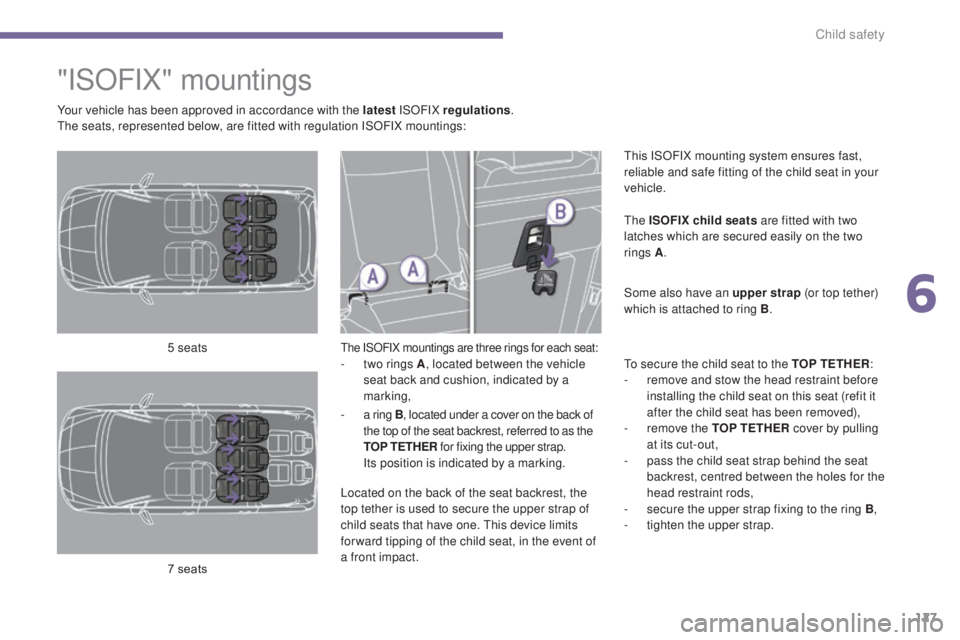
127
5008_en_Chap06_securite-enfants_ed01-2015
"ISOFIX" mountings
The ISOFIX mountings are three rings for each seat:- two rings A, located between the vehicle
seat back and cushion, indicated by a
marking, This ISOFIX mounting system ensures fast,
reliable and safe fitting of the child seat in your
vehicle.
The ISOFIX child seats are fitted with two
latches which are secured easily on the two
rings A
.
Some also have an upper strap (or top tether)
which is attached to ring B .
To secure the child seat to the TOP TETHER :
- r emove and stow the head restraint before
installing the child seat on this seat (refit it
after the child seat has been removed),
-
r
emove the TOP TETHER cover by pulling
at its cut-out,
-
p
ass the child seat strap behind the seat
backrest, centred between the holes for the
head restraint rods,
-
s
ecure the upper strap fixing to the ring B,
-
t
ighten the upper strap.
5 seats
7 seats
Your vehicle has been approved in accordance with the latest ISOFIX
regulations.
The seats, represented below, are fitted with regulation ISOFIX mountings:
-
a r
ing B, located under a cover on the back of
the top of the seat backrest, referred to as the
TOP TETHER for fixing the upper strap.
I
ts position is indicated by a marking.
Located on the back of the seat backrest, the
top tether is used to secure the upper strap of
child seats that have one. This device limits
for ward tipping of the child seat, in the event of
a front impact.
6
Child safety
Page 130 of 364
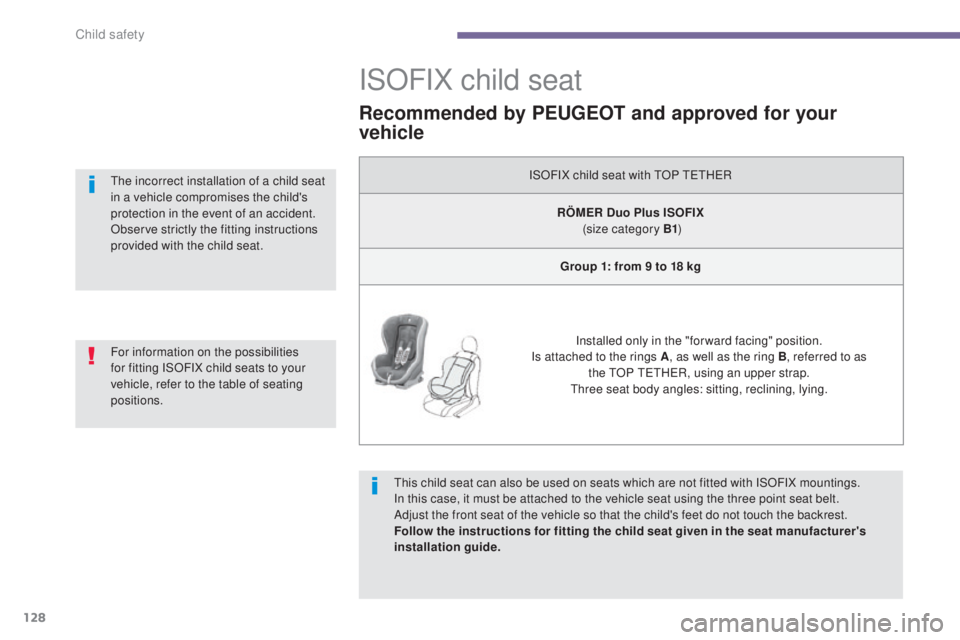
128
5008_en_Chap06_securite-enfants_ed01-2015
ISOFIX child seat
This child seat can also be used on seats which are not fitted with ISOFIX mountings.
In this case, it must be attached to the vehicle seat using the three point seat belt.
Adjust the front seat of the vehicle so that the child's feet do not touch the backrest.
Follow the instructions for fitting the child seat given in the seat manufacturer's
installation guide.
For information on the possibilities
for fitting ISOFIX child seats to your
vehicle, refer to the table of seating
positions. The incorrect installation of a child seat
in a vehicle compromises the child's
protection in the event of an accident.
Observe strictly the fitting instructions
provided with the child seat.
Recommended by PEUGEOT and approved for your
vehicle
ISOFIX child seat with TOP TETHER
RÖMER Duo Plus ISOFIX
(size category B1 )
Group 1: from 9 to 18 kg
Installed only in the "forward facing" position.
Is attached to the rings A , as well as the ring B, referred to as
the TOP TETHER, using an upper strap.
Three seat body angles: sitting, reclining, lying.
Child safety
Page 131 of 364
129
5008_en_Chap06_securite-enfants_ed01-2015
Seating positions for installing ISOFIX child seats
In accordance with European Regulations, this table indicates the options for installing ISOFIX child seats on seats in the vehicle fitted with ISOFIX
mountings.
In the case of universal and semi-universal ISOFIX child seats, the ISOFIX size category, determined by a letter between A and G, is indicated on the
child seat next to the ISOFIX logo.
Weight of the child / indicative age
Less than 10 kg (group 0)
Up to approx. 6 months Less than 10 kg
(group 0)
Less than 13 kg (group 0+)
Up to approx. 1 year From 9 to 18 kg (group 1)
From approx. 1 to 3 years
Type of ISOFIX child seat Shellrearward facing rearward facing forward facing
ISOFIX size categor y F G C D E C D A B B1
Front passenger seat XXXX
5 seats (2 r ow s)
Outer rear seats IL- SU* IL- SU* IL- SU* IUF
*
IL- SU*
Centre rear seat XIL- SU IL- SU IUF
IL- SU
6
Child safety
Page 133 of 364
131
5008_en_Chap06_securite-enfants_ed01-2015
Weight of the child / indicative age
Less than 10 kg (group 0)
Up to approx. 6 months Less than 10 kg
(group 0)
Less than 13 kg (group 0+)
Up to approx. 1 year From 9 to 18 kg (group 1)
From approx. 1 to 3 years
Type of ISOFIX child seat Shell"rearwards-facing"
"rearwards-facing""forwards-facing"
ISOFIX size categor y F G C D E C D A B B1
Front passenger seat XXXX
7 seats (3 r ow s)
Outer rear seats 2nd row IL- SU* IL- SU* IL- SU* IUF
*
IL- SU *
Centre rear seat 2nd row XIL- SU IL- SU IUF
IL- SU
Rear seats 3rd row Not Isofix
6
Child safety
Page 135 of 364
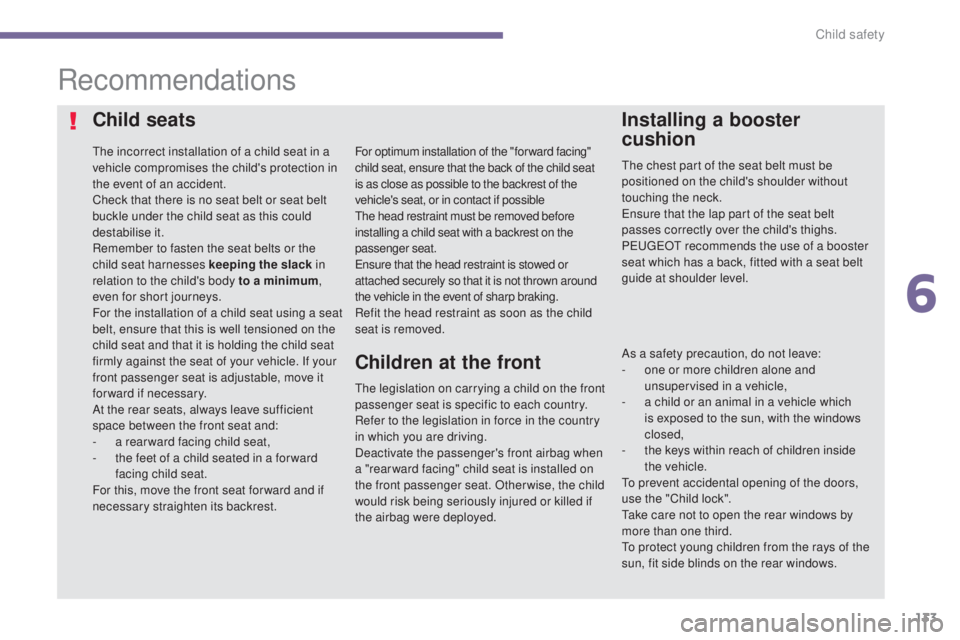
133
5008_en_Chap06_securite-enfants_ed01-2015
Recommendations
Child seats
The incorrect installation of a child seat in a
vehicle compromises the child's protection in
the event of an accident.
Check that there is no seat belt or seat belt
buckle under the child seat as this could
destabilise it.
Remember to fasten the seat belts or the
child seat harnesses keeping the slack in
relation to the child's body to a minimum,
even for short journeys.
For the installation of a child seat using a seat
belt, ensure that this is well tensioned on the
child seat and that it is holding the child seat
firmly against the seat of your vehicle. If your
front passenger seat is adjustable, move it
forward if necessary.
At the rear seats, always leave sufficient
space between the front seat and:
-
a r
ear ward facing child seat,
-
t
he feet of a child seated in a for ward
facing child seat.
For this, move the front seat for ward and if
necessary straighten its backrest.
Children at the front
For optimum installation of the "forward facing"
child seat, ensure that the back of the child seat
is as close as possible to the backrest of the
vehicle's seat, or in contact if possible
The head restraint must be removed before
installing a child seat with a backrest on the
passenger seat.
Ensure that the head restraint is stowed or
attached securely so that it is not thrown around
the vehicle in the event of sharp braking.
Refit the head restraint as soon as the child
seat is removed.
The legislation on carrying a child on the front
passenger seat is specific to each country.
Refer to the legislation in force in the country
in which you are driving.
Deactivate the passenger's front airbag when
a "rear ward facing" child seat is installed on
the front passenger seat. Otherwise, the child
would risk being seriously injured or killed if
the airbag were deployed.
Installing a booster
cushion
The chest part of the seat belt must be
positioned on the child's shoulder without
touching the neck.
Ensure that the lap part of the seat belt
passes correctly over the child's thighs.
PEUGEOT recommends the use of a booster
seat which has a back, fitted with a seat belt
guide at shoulder level.
As a safety precaution, do not leave:
-
o
ne or more children alone and
unsupervised in a vehicle,
-
a c
hild or an animal in a vehicle which
is exposed to the sun, with the windows
closed,
-
t
he keys within reach of children inside
the vehicle.
To prevent accidental opening of the doors,
use the "Child lock".
Take care not to open the rear windows by
more than one third.
To protect young children from the rays of the
sun, fit side blinds on the rear windows.
6
Child safety
Page 141 of 364
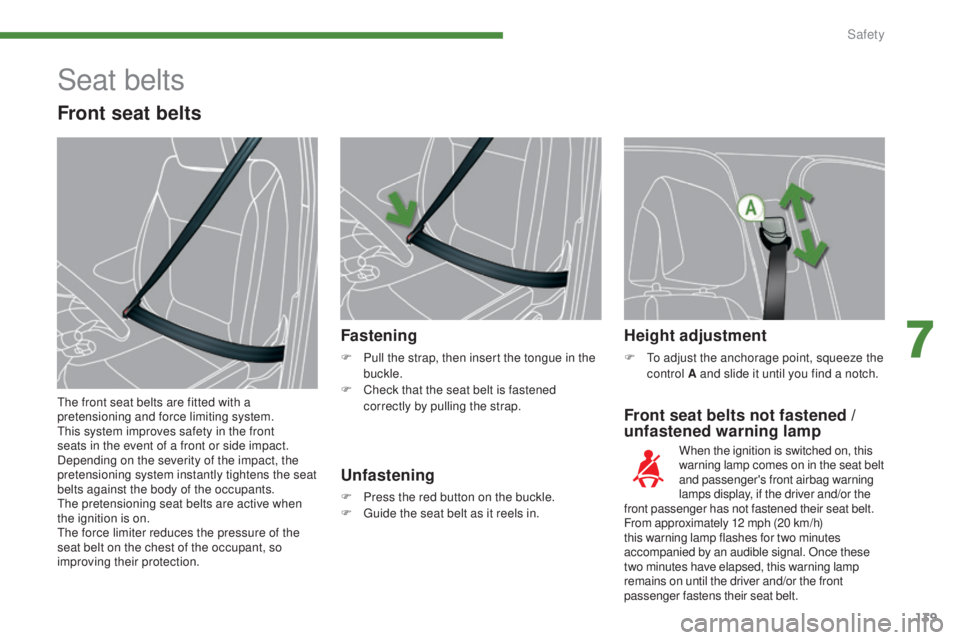
139
5008_en_Chap07_securite_ed01-2015
Front seat belts not fastened /
u nfastened warning lamp
Fastening
F Pull the strap, then insert the tongue in the
buckle.
F
C
heck that the seat belt is fastened
correctly by pulling the strap.
Height adjustment
F To adjust the anchorage point, squeeze the control A and slide it until you find a notch.
When the ignition is switched on, this
warning lamp comes on in the seat belt
and passenger's front airbag warning
lamps display, if the driver and/or the
front passenger has not fastened their seat belt.
From approximately 12 mph (20 km/h)
this warning lamp flashes for two minutes
accompanied by an audible signal. Once these
two minutes have elapsed, this warning lamp
remains on until the driver and/or the front
passenger fastens their seat belt.
Unfastening
F Press the red button on the buckle.
F
G uide the seat belt as it reels in.
Seat belts
Front seat belts
The front seat belts are fitted with a
pretensioning and force limiting system.
This system improves safety in the front
seats in the event of a front or side impact.
Depending on the severity of the impact, the
pretensioning system instantly tightens the seat
belts against the body of the occupants.
The pretensioning seat belts are active when
the ignition is on.
The force limiter reduces the pressure of the
seat belt on the chest of the occupant, so
improving their protection.
7
Safety